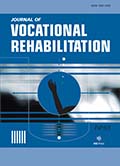Authors: Lau, Stephanie J. | McKelvey, Susan
Article Type:
Brief Report
Abstract:
BACKGROUND: Passage of the Workforce Innovation and Opportunity Act (WIOA) of 2014 placed an emphasis on increasing student education and preparation for employment for students as young as 14. When Virginia Commonwealth University (VCU) was awarded a grant from the National Institute on Disability, Independent Living, and Rehabilitation Research (NIDILRR) to establish a Rehabilitation and Research Training Center (RRTC) on employment for transition-age youth with disabilities, one of the studies focused on knowledge translation methods to develop and deliver a toolkit to assist VR counselors (and others) providing pre-employment transition services (Pre-ETS) to students 14 to 16 years of age
…with significant disabilities. OBJECTIVE: The purpose of this practice brief is to share preliminary findings from Phase 1 and Phase 2 of VCU-RRTC on Employment of Transition-Age Youth with Disabilities’ study, Effects of Knowledge Translation Methods on Vocational Rehabilitation Counselors Providing Pre-ETS to Youth with Significant Disabilities 14–16 years of age. METHOD: To prepare this practice brief, program staff conducted a thematic analysis of interview findings from Phase 1 and reviewed program materials from Phase 2 to identify preliminary observations. Program materials included instructor case notes, student reports, student pre- and post-tests, interviews with families, vocational rehabilitation counselors, and school staff after instruction. RESULTS: From Phase 1, VR counselors, educators, and families desired early exposure to career exploration and felt that interest-driven experiences and education was generally lacking. From Phase 2, it was observed that lesson content needed to be relevant and engaging to younger students, who often had a very abstract understanding of work and limited self-awareness about career interests, personal interests, and strengths. CONCLUSION: Preliminary findings from Phase 1 and Phase 2 of the study underscore the desire and need to increase collaboration between educators, vocational rehabilitation counselors, and families. Observations from Phase 2 demonstrate the value of Pre-ETS instruction to younger students with significant disabilities, and how increased collaboration can prepare students for employment through early career exploration, workplace readiness skills, and community based work experiences.
Show more
Keywords: Pre-ETS, significant disabilities, students, collaboration
DOI: 10.3233/JVR-230012
Citation: Journal of Vocational Rehabilitation,
vol. 58, no. 3, pp. 249-256, 2023





